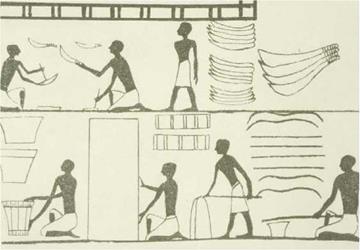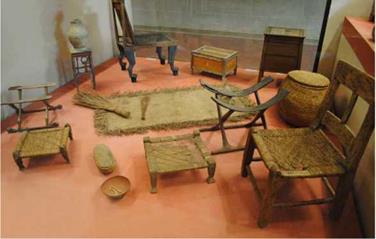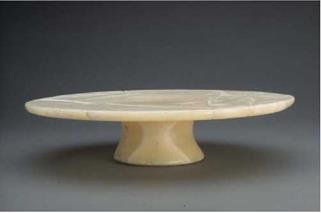Ancient Egypt
Early Dynastic Period (3100-2575 BCE)
Egypt evolved from an unsettled society into a politically secure, economically strong, technologically advanced, and culturally unified civilization along the Nile River. Egypt was, and
 remains today, a land of few trees, but examples of wooden furniture have been preserved because they were buried in the tombs of kings and queens. Clearly, central trading among societies from different regions occurred in Egypt. Wood was imported and furniture was exported to neighboring countries. Craftsmen learned how to make and decorate a variety of freestanding furniture pieces (Figure 10.3). The furniture known to us from the Early Dynastic Period was well crafted, ornate, and fabricated using several materials. Craftsmen used a range of hand tools to manipulate wood, stone, metal, and glass. So important were the fabricators, along with the furnishings they made for the ruling society, that craftsmen were buried in royal tombs Figure 10.3 Egyptian craftsmen. Photography courtesy of John Stork. along with their tools.3
remains today, a land of few trees, but examples of wooden furniture have been preserved because they were buried in the tombs of kings and queens. Clearly, central trading among societies from different regions occurred in Egypt. Wood was imported and furniture was exported to neighboring countries. Craftsmen learned how to make and decorate a variety of freestanding furniture pieces (Figure 10.3). The furniture known to us from the Early Dynastic Period was well crafted, ornate, and fabricated using several materials. Craftsmen used a range of hand tools to manipulate wood, stone, metal, and glass. So important were the fabricators, along with the furnishings they made for the ruling society, that craftsmen were buried in royal tombs Figure 10.3 Egyptian craftsmen. Photography courtesy of John Stork. along with their tools.3
|

Significant knowledge about furniture making existed in the first Egyptian Dynasty (3200-2980 BCE), based on evidence of the skill used to make mortise-and-tenon, dovetail, and miter joints, copper and bronze fittings, and chests with bolted systems. Tools included mallets, copper and bronze saws, axes, chisels, adzes, and drills. Adzes were used to plane wood similarly to the way we use hand planes today. It is interesting to note that the hand tools and fabrication methods used in ancient Egypt remained constantly in use up to the early nineteenth century. The materials and tools used in ancient Egypt reveal a desire to fabricate beautiful, long-lasting pieces. The high quality of the workmanship indicates a culture thoughtful about design.
Danish professor Dan Svarth spent years researching, drawing, and modeling Egyptian furnishings at a 1:5 scale (Figure 10.4). He concludes that the ancient Egyptians used steambending technology to shape and form wood for their chariots and furniture. This is the first record of steam-bending technology used in the fabrication of furniture.
Ancient Egypt was a place of historical beginnings, many of which have influenced the history of furniture design in regard to typology, social status, form, and material. Significantly, 2600 BCE is the date of the first known furniture designer. He was an Egyptian priest named Hesyre and was known to have designed furniture using 1:1 scale drawings of beds and other furnishings found at his tomb.4
Native Egyptian woods included acacia and African ebony, while cypress and cedar were imported from Syria and Lebanon.5 Carved African ivory was commonly incorporated into the legs of furniture. Ebony, due to its density and stability, enabled veneer techniques to develop. The use of these materials in furniture illustrates a desire for stability and also points to active regional trade, experienced craftsmen, and the significance placed on eating, sleeping, and the afterlife.
Old Kingdom (2575-2134 BCE)
During the Old Kingdom, wooden coffins were fabricated with butt and miter joints secured with wooden dowels and shoulder miters. While dovetails, scarf joints, and halving joints were used, miter and shoulder miter joints exhibited sophisticated joining techniques, revealing how innovative the Egyptians were in using fabrication techniques. Whether the Egyptians invented these techniques or learned them from other societies, they increased the quality of workmanship and established a precedent for working with hand tools that lasted for millennia.
In 1925, a suite of furniture was discovered in a chamber within a pyramid and tomb built for Queen Hetepheres and her husband and Pharaoh Snefru, ca. 2300 BCE. The suite of furniture included an armchair with animal legs, a bed, headrest, framing members to support draperies, a box to store the drapery, and a box for jewelry.
Beds and cosmetic boxes were used by both royalty and common people. Three – and four-legged stools were portable, practical, and easy to fabricate. Other furniture typologies from the Old Kingdom include bed platforms, chairs, game furnishings, storage chests, and tables. Storage chests were used as containers for clothing, cosmetics, household items, and jewelry. Most people slept on floor mats, but bed frames were used by the privileged. Bed platforms had elaborate footboard panels incorporated in their design, and rigid headrests were applied to support the head at the open and lower end of the platforms (Figure 10.5). By the New Empire (1550-1069 BCE) painted wood furnishings were common (Figure 10.6). Tables were generally rectangular and used for display, work, and dining. Smaller offering tables were fabricated with remarkable craft, often out of stone (Figure 10.7). Straight-backed and reclining chairs, with and without arms, were made of wood. Surviving chairs from various tombs illustrate beautifully carved open work, painted and decorated examples that incorporated gilding, inlay, and veneer work.
Basketwork was made of coiled fibers, including palm, papyrus, reed, and alfalfa grass. Relatively small, low X-chairs were made resilient with interlaced cords and leather thongs
|
|
|
|
|
 Figure 10.9 Chairs, stools, tables and storage chests taken from an Egyptian cemetery located in front of Deir el-Medineh (1450-1350 BCE). Photography by Jim Postell, 2011.
Figure 10.9 Chairs, stools, tables and storage chests taken from an Egyptian cemetery located in front of Deir el-Medineh (1450-1350 BCE). Photography by Jim Postell, 2011.
(Figure 10.8). The use of grasses and plants in furniture illustrates that the Egyptians considered comfort in the chairs found in their tombs (Figure 10.9).





